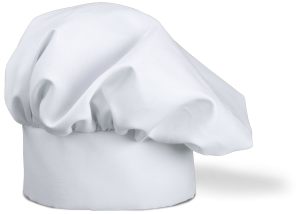The original chef’s uniform was so well suited to the needs of a chef, it didn’t change much in nearly 200 years. New changes to the traditional uniform mostly borrow from other professions to take advantage of modern advances in technology and workwear.
For instance, some chefs have switched from wearing cotton uniforms to donning polyester blends. Blends are easier to clean and have improved ventilation. The coolest chefs even wear undershirts like those worn by athletes to wick sweat away from their bodies. Modern climate-controlled kitchens have made neckerchiefs (once used to mop off a sweaty brow) less useful, but they are still worn in formal dining situations as a nod to traditional kitchen fashion.
Disposable gloves have greatly improved sanitization and safety. Chefs now wear food service quality gloves that protect from heat, improve their grip, defend against knife cuts and, of course, prevent contamination of food and kitchenware.
Aprons have gone from shorter to fuller. Modern aprons sometimes extend upwards to cover the chest and even shoulders. They provide additional protection from spills and heat while also giving chefs extra pockets to store gear (or a smartphone). The chef can also just slip the apron off to greet guests, ensuring a tidier uniform underneath.

Chef pants have also evolved over the years. The traditional houndstooth pattern has in many restaurants been replaced by a less busy checkered pattern or simple stripes. Cooks often display individuality with unique designs, especially when they don’t have to greet guests or if they are always behind a waist-high kitchen line. Chef pants have also gotten baggier over the years in order to facilitate ease of movement and help chefs stay cool in a hot kitchen.
In a profession where people are on their feet for hours and injuries are often caused by slipping on wet floors, advancements in restaurant shoes may be the most crucial change to the traditional uniform. Non-slip shoes historically had rough leather bottoms, but now improved rubber soles give a much better grip on slippery surfaces. Reinforced steel toe shoes also protect little piggies from getting stubbed on heavy equipment or fixtures.
Some people are surprised to find out that clogs are very popular among chefs. Clogs are comfy and they can be kicked off quickly if hot liquid or food is spilled on them. Chef Escoffier used them as far back as the 1890’s, but clogs have changed a bit since then. In the 1990’s chefs like Mario Batali began wearing the same polyurethane clogs used by surgeons. According to the New York Times article “Chefs and Shoes” by Suzanne Hamlin, he keeps them “surgically clean” by sanitizing them once a week in a dishwasher.

The New American restaurant movement in the 1980’s provided a challenge to the classic white toque hat of the chef. Wolfgang Puck wore his baseball hat, admitting it was not much of an improvement upon the toque, but it was less formal. Hairnets, bandanas and more utilitarian headwear often replaces the pillowy chef’s crown, while prestige is now measured by Michelin or Yelp stars rather than a chef’s appearance.
The pristine white chef’s uniform harkens back 200 years, but it has seen numerous modern updates. Nonetheless, kitchen-wear (see what we did there?) is still some of the most recognizable attire in the world. Chefs continue to wear elements of the original uniform in just about every city. In many restaurants, crisp, freshly laundered apparel is delivered daily or weekly by professional uniform services. Modern advancements help keep chefs looking as sharp as their knives.
Register your business for free with NPP and receive discounts on essential items you use every day, including UniFirst uniform and facility services. More than 300,000 NPP members boost their bottom line with money-saving, convenient contract pricing. Learn more about NPP.
